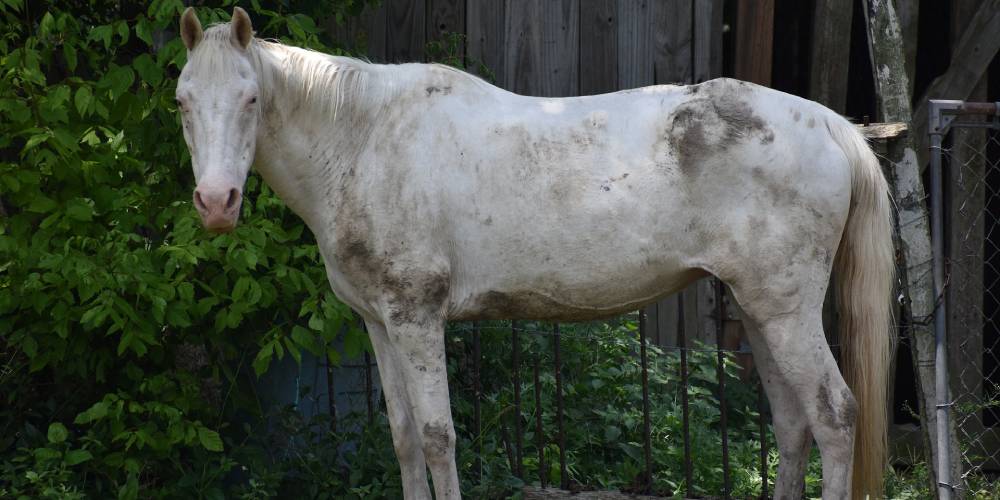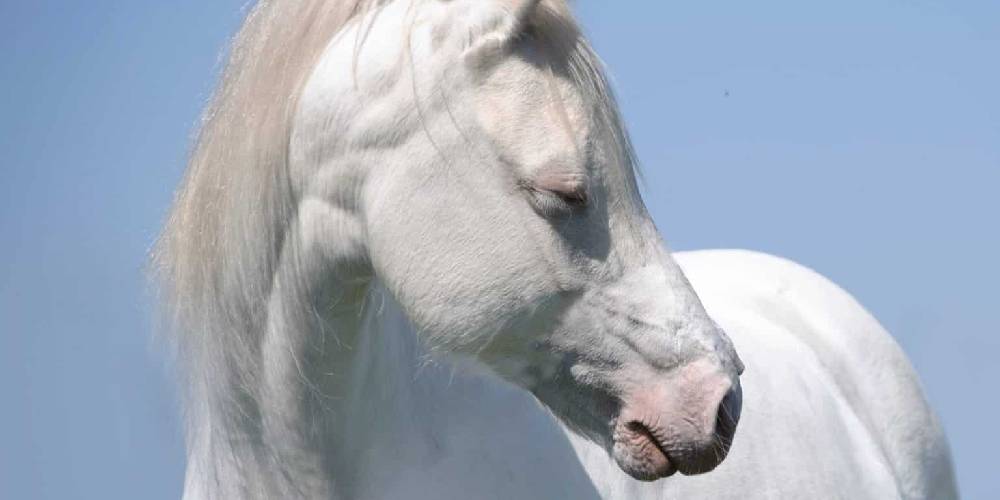Did you know that most of the ‘white’ horses you see aren’t actually called white? In fact, most of these ‘white horses’ are actually called gray. A true white horse, or what you are going to read about shortly, is actually also able to be classified as albino. This is because white horses not only have completely white coats, manes, and tails, they also have white hooves, pale eyes, and pink skin!
What Is A White Or Albino Horse?
A true white horse or an albino horse is a horse that has a completely white coat, pink skin, a white mane and tail, and pale eyes. White horses are often confused with grey horses as both have white coats. The difference is that a grey horse has black skin while a white horse has pink skin or skin that lacks pigmentation. Albinism is likely caused by two copies of a dilution gene inherited from each of the horse’s parents. Because of this, albino horses/true white horses must inherit their coloration from their parents.
What Does The Albino Or White Coat Color Look Like?

These horses have very distinct traits and characteristics that set this coloration apart from any other coat color found in horses. These traits can be found in the horse’s:
Coat Color
The coat color of a true white horse is always a pure white color. There will be no dark markings, spots, tints, or speckles found anywhere in the entire coat. These horses should always have a spotless coat that is often seen with a pearl-like shine.
Skin Color
Horses that are truly white or albino in color will ALWAYS have pink skin. There are many horses who will have a white coat and pink skin, but can’t be considered truly white or albino because they have dark speckles and mottled skin. All albino horses or white horses must have pure white skin from their muzzle to their tail or else they can’t be considered white.
Eye Color
Because these horses have no pigmentation, this means that the color of their eyes is also diluted. The average horse has brown eyes, but horses with albinism, have pale blue, white, or pink eyes most commonly.
Mane & Tail Color
Like the coat color, the mane and tail of the white or albino horse must be white to be considered white or albino. Any existing pigmentation in the horse’s tail will automatically make it not able to be considered white.
Hoof Color
As you might notice in horses that have white socks or other white leg markings, the hoof on that leg is white. This is true also in albino or white horses as their whole body is white. The hooves of these horses will be white in color and carry no dark markings because of the absence of pigmentation in the horse’s body.
Is There A Difference Between Albino & White?
There really isn’t a difference between albino and white horses when it comes to appearance and sometimes even genetics. The only exception to this that I can think of is if a horse is considered paint or a pinto horse because of genetics but lacks any dark markings typically seen in a pinto. This is uncommon, but still entirely possible in certain horses if white is more dominant than another color in the pinto horse’s genetics.
What Is The Difference Between White & Grey Horses?

There are several differences between white and gray horses. Some of these include the differences between the horse’s:
Coat Color
There are a few differences in the coat color of these horses. The main three are:
- Albino horses are NOT born black, bay, or chestnut as gray horses are
- Albino horses can NOT have little colored flecks in their coat as fleabitten gray horses do
- Albino horses will NOT ever have dapples in their coat like a dappled gray might have
Albino horses will NEVER have any color in their coat other than white
Mane & Tail Color
White horses will always have a pure white mane and tail with no differently colored hairs mixed in. This is different for gray horses who will sometimes still carry dark hairs in their manes and tails even after they are completely grayed over.
Eye Color
Gray horses will almost always have brown or dark-colored eyes. This is because, even though they have a light-colored coat, they still carry a lot of pigmentation as compared to albino horses.
Albino horses will never be seen with dark colored eyes as this is a trait seen only in horses with dark skin. The most common colors for eyes seen in albino horses include:
- Pale blue
- White
- Pale pink
Hoof Color
Because of the lack of pigmentation seen in white horses, the hooves on these horses are also seen in white. Gray horses however, will almost always have dark colored hooves unless an undetectable white marking exists on a horse’s leg.
Skin Color
Gray horses will always have black skin. This can be seen in the color of their muzzle and the color of the skin around their eyes.
White or albino horses will always have pink skin that lacks any pigmentation. This too can be seen in the color of the horse’s muzzle and the color of the skin around the horse’s eyes.
Can White Horses Have Markings?
No, white horses, to be considered truly white or albino, must always have pure white skin and a pure white coat. If there is any sort of dark marking, spotting, or mottling of the skin, the horse may not be able to carry the title of a true albino or white horse. These horse’s can not have any pigmentation so if pigmentation is present, they are not truly an albino horse.
Because of their white coat color, it is impossible to see if these horses carry any genetics for white facial or leg markings.
Are White Or Albino Horses Rare?

Yes! Believe it or not, white or albino is actually possibly classified as the most rare color seen in the horse world. This is because not only do many breeds not allow this color, but the genetics and breeding for this color is not common either.
Breeds That Can Be True White
Because of selective coloration of a number of breeds, there are only a few horse breeds that allow horses to be albino. These breeds include:
- Andalusian
- Mustang
- Thoroughbreds
- Arabians
- American White Horse
- Camarillo White Horse
- Quarter Horse
Breeds That Can’t Be True White
Because of a number of breed rules and restrictions set in place regarding the coat color of certain horses, Most horses can’t be truly white. A few examples of some horse breeds that can’t be truly white in color include:
- Cleveland Bay
- Haflinger
- Belgian Horse
- Fjord Pony
- Konik Ponies
- Przewalski’s Horse
- Shire
- Clydesdale
- Suffolk Punch Draft Horses
Can The Albino Or White Coat Color Affect The Horse’s Health?

Unfortunately, this coat color can play a role in the negative health of horses who carry it. This is because of the absence of pigmentation in this coat color. The way this is negative is that this removes the pigmentation that would normally act as a natural barrier to the sun. These horses are naturally more prone to:
- Skin issues
- Sun burn
- Skin cancer
Fun Facts On White Horses
- A horse can only be called white if it has pure pink skin. If the skin is dark, it is actually a gray horse
- This color is one of the rarest in the world

